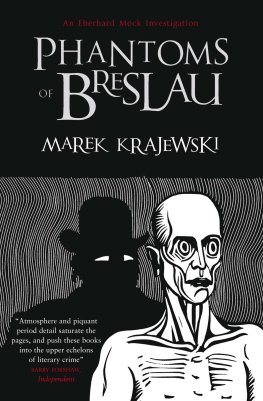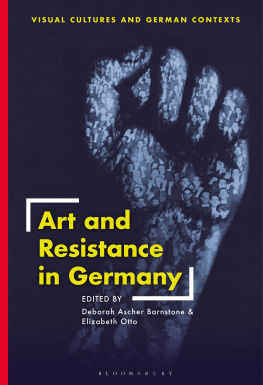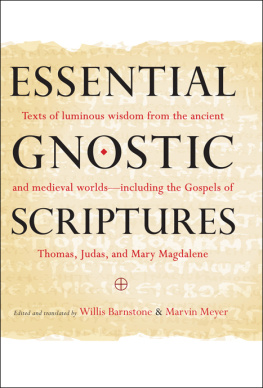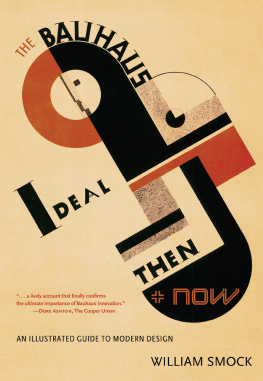Deborah Barnstone - Beyond the Bauhaus: Cultural Modernity in Breslau, 1918-33
Here you can read online Deborah Barnstone - Beyond the Bauhaus: Cultural Modernity in Breslau, 1918-33 full text of the book (entire story) in english for free. Download pdf and epub, get meaning, cover and reviews about this ebook. year: 2018, publisher: University of Michigan Press, genre: Art. Description of the work, (preface) as well as reviews are available. Best literature library LitArk.com created for fans of good reading and offers a wide selection of genres:
Romance novel
Science fiction
Adventure
Detective
Science
History
Home and family
Prose
Art
Politics
Computer
Non-fiction
Religion
Business
Children
Humor
Choose a favorite category and find really read worthwhile books. Enjoy immersion in the world of imagination, feel the emotions of the characters or learn something new for yourself, make an fascinating discovery.
- Book:Beyond the Bauhaus: Cultural Modernity in Breslau, 1918-33
- Author:
- Publisher:University of Michigan Press
- Genre:
- Year:2018
- Rating:3 / 5
- Favourites:Add to favourites
- Your mark:
- 60
- 1
- 2
- 3
- 4
- 5
Beyond the Bauhaus: Cultural Modernity in Breslau, 1918-33: summary, description and annotation
We offer to read an annotation, description, summary or preface (depends on what the author of the book "Beyond the Bauhaus: Cultural Modernity in Breslau, 1918-33" wrote himself). If you haven't found the necessary information about the book — write in the comments, we will try to find it.
Beyond the Bauhaus: Cultural Modernity in Breslau, 1918-33 — read online for free the complete book (whole text) full work
Below is the text of the book, divided by pages. System saving the place of the last page read, allows you to conveniently read the book "Beyond the Bauhaus: Cultural Modernity in Breslau, 1918-33" online for free, without having to search again every time where you left off. Put a bookmark, and you can go to the page where you finished reading at any time.
Font size:
Interval:
Bookmark:
 Page i
Page i 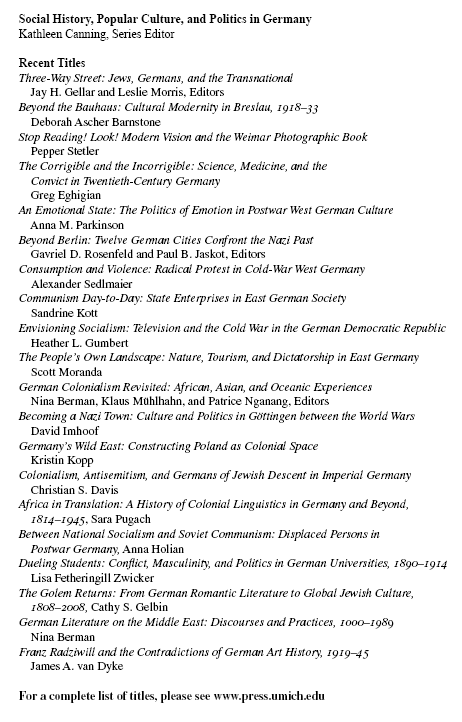 Page iii
Page iii Deborah Ascher Barnstone
University of Michigan Press
Ann Arbor
Page iv Copyright Deborah Ascher Barnstone 2016
All rights reserved
This book may not be reproduced, in whole or in part, including illustrations, in any form (beyond that copying permitted by Sections 107 and 108 of the U.S. Copyright Law and except by reviewers for the public press), without written permission from the publisher.
Published in the United States of America by the
University of Michigan Press
Manufactured in the United States of America
A CIP catalog record for this book is available from the British Library.
Library of Congress Cataloging-in-Publication Data
Names: Barnstone, Deborah Ascher, author.
Title: Beyond the Bauhaus : cultural modernity in Breslau, 191833 / Deborah Ascher Barnstone.
Description: Ann Arbor : University of Michigan Press, [2016] | Series: Social history, popular culture, and politics in Germany | Includes bibliographical references and index.
Identifiers: LCCN 2016010865| ISBN 9780472119905 (hardcover : acid-free paper) | ISBN 9780472121946 (e-book)
Subjects: LCSH: Wrocaw (Poland)Civilization20th century. | Wrocaw (Poland)Intellectual life20th century. | Modernism (Aesthetics)PolandWrocawHistory20th century. | Arts, GermanPolandWrocawHistory20th century. | City and town lifePolandWrocawHistory20th century. | BauhausInfluenceHistory. | GermanyIntellectual life20th century. | GermanyHistory19181933.
Classification: LCC DK4780.2 .B37 2016 | DDC 709.438/52dc23
LC record available at https://lccn.loc.gov/2016010865
Page v To my beloved husband, Robert, and children,
Alexi and Maya
Page vi Page viiI first heard of the city of Breslau as a child from my father, Abraham Ascher, who was born there. I must confess, however, that for decades the city remained only a remote name since my fathers family had all fled or been murdered by the Nazis, and Breslau after the war became Wroclaw, a Polish city situated behind the Iron Curtain that was virtually inaccessible to those of us in the West. Indeed, I knew shamefully little of my fathers Heimatstadt until my father decided to author his own study on the city, specifically on the Jewish community that had resided there during the Nazi period between 1933 and 1941. It was, in fact, toward the final stages of producing his book that my father called one day to inform me that he had discovered material of art historical interest that might prove interesting to me. He sent me a small collection of official Nazi correspondence from 193537 about the extraordinary art Nazi officials had discovered in private Jewish collections in Breslau. My father was correct; the letters were a revelation, although not precisely for the reasons that he had anticipated. For, as I researched Breslau, I soon discovered that it had been home to an extraordinary community of forward-thinking people during the 1920s who were arts patrons but also artists, architects, and urban designers, many of whom are still world renowned today. Equally exciting was the discovery that almost none of this history had been documented or disseminated in any language, much less in the English-speaking world. Thus, I have to thank my father first and foremost for this project.
As with any book-length study there are innumerable people who offered support, advice, and expertise along the way. Franziska Bollerey enthusiastically encouraged me to pursue the project when I was formulating the idea for the book. The German Academic Exchange Service, Washington State University Saupe Fund for Excellence, the Technical University Delft, and University of Technology Sydney Centre for Contemporary Design Practice helped defray Page x the costs of traveling to Germany and Poland in order to conduct the necessary archival research. The archivists at the Wroclaw state archive, University of Wroclaw Library, the Ethnographic Museum, and the Architecture Museum in Wroclaw gave me invaluable help locating materials and permitted me to photocopy enormous quantities of material relevant to my work. I owe a special thanks to Jerzy Ilkosz, Piotr ukaszewicz, and Juliet Golden. Juliet was indomitable chasing down images and permissions for me. Beate Strtkuhl at the Bundesinstitut fr Kultur und Geschichte der Deutschen im stlichen Europa pointed me in the right direction at the beginning of the research and generously shared some excellent resource material from her institute with me. The archivists at the German National Museum in Nuremburg; Staatsbibliothek in Berlin; the Stiftung Preussischer Kulturbesitz; the Werkbund Archive; the Bauhaus Archive; and the Academy of the Arts, in particular Heidemarie Bock; Petra Albrecht; Tanja Morgenstern; and Dr. Eva-Marie Barkofen went beyond the call of duty in order to offer assistance.
In addition to sitting in archives and libraries, I was fortunate to be able to interview several people who offered vital perspectives on Breslau; the interview with Brigitte Wrtz, Oskar Molls daughter, helped me understand the cultural milieu in Breslau during the 1920s as well as the outstanding art made by both her parents; the interview with Chaim Haller about his wife Ruths father, Ismar Littmann, provided me with important insights into collecting in Breslau; Walter Laqueur shared some key memories; and the lawyer Willi Korte helped me understand the complex nature of looted art research and recovery.
Portions of three chapters were previously published as articles. Part of chapter 4, The Breslau Academy of Fine and Applied Arts, was published in the Journal of Architectural Education; part of chapter 6, Between Idealism and Realism: Architecture in Breslau, was published in the New German Critique; and part of chapter 5, Dissemination of Taste: Breslau Collectors, Art Associations, and Museums, was published in The Art Journal. In addition, much of the material in this book was initially tested in academic conference presentations, from which I received detailed and valuable feedback. These included the German Studies Association and the Association of Art Historians of Great Britain.
The two readers for University of Michigan Press, professors Elizabeth Otto and Claire Zimmerman, both gave the manuscript a thorough reading, delivering extremely insightful and helpful criticism and direction at a crucial time in the project. Without their tough but thoughtful comments, the book would have been far weaker indeed. Lastly, I would like to thank my husband, Page xi Robert, and my children, Alexander and Maya, who all tolerated my obsession with Breslau, my frequent absences, and hours upon hours spent glued to my computer. My children are convinced that I cannot survive without my laptop! Without their love and support, I would not have completed this book. As with every such endeavor, the strengths exist because of the many people who supported me. As to the faultsI have no one to blame but myself.
Page xii Page 1The very intricacy and variety of Weimar culture, and the tensions it contains, have made it the archetypal emblem of what we understand by modernity.
Detlev Peukert, The Weimar Republic
In 1899, a Prussian official approached Theo von Gosen, a young sculptor who was to become one of Breslaus most important artists, to suggest that he consider a teaching career at the Breslau Academy of Fine and Applied Arts. But Breslaus lure proved more powerful than von Gosen expected. Twice more, in 1903 and 1905, architect Hans Poelzig, a strange looking, out-of-place, black haired man, tried to recruit him to the Academy. By Poelzigs third attempt in 1905, von Gosen reluctantly decided to give Breslau a try, largely because it was proving impossible to break into Munichs art market. Like many of his contemporaries, von Gosen saw Breslau as a remote backwater at the fringes of civilization, where no art of consequence wasor could beproduced. But when he got there, he discovered a rich, varied, and supportive arts community whose composition illustrates the diversity of the eras German culture, along with its complex and diverging paths to cultural modernity.
Font size:
Interval:
Bookmark:
Similar books «Beyond the Bauhaus: Cultural Modernity in Breslau, 1918-33»
Look at similar books to Beyond the Bauhaus: Cultural Modernity in Breslau, 1918-33. We have selected literature similar in name and meaning in the hope of providing readers with more options to find new, interesting, not yet read works.
Discussion, reviews of the book Beyond the Bauhaus: Cultural Modernity in Breslau, 1918-33 and just readers' own opinions. Leave your comments, write what you think about the work, its meaning or the main characters. Specify what exactly you liked and what you didn't like, and why you think so.


